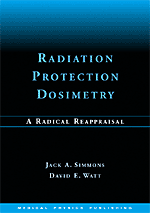
Radiation Protection Dosimetry: A Radical Reappraisal
Author: Jack Simmons & David WattISBN: 9780944838877 ISBN10: 0944838871
Published: 1999 | 160 pp |
OUT OF PRINT
Canadian Medical Physics | April 1999
Canadian Medical Physics Newsletter April 1999
"This book presents an alternative approach to current radiation protection dosimetry. It points out the many defects and limitations of the present radiation protection paradigm and shows that the current assumptions are the cause of much misunderstanding, erroneous risk estimations and misdirected expense in this field.
"The first chapter takes a brief steip back in time to review an analogous situation in the history of astronomy, and then the second chapter describes the development of radiation protection philosophy from the beginning, pointing out scientific lapses which occurred, and comparing the circumstances with the astronomical analogy. In the third chapter, ICRP 60 is analysed from this perspective, and further problems with the new concepts therein are laid out.
"In chapter 4, there is a thorough review of the most widely used simulation models of biophysical effectiveness, and the conclusion is reached that the physical mechanisms of radiation action in them are not valid. Chapter 5 investigates radiation as a probe for the physical investigation of radiosensitive structure in biological targets, and concludes that radiation quality is determined by the mean free path for linear primary radiation.
"Chapter 6 concludes that the correct approach would use a fluence-based system for radition protection, and that it is feasible to construct and use detectors which would measure the absolute bioeffectiveness of any radiation type by simulating the response of intracellular DNA. The detector output would be the equivalent of the number of double strand breaks produced per unit fluence.
"The final chapter (seven) includes these four conclusions:
1 Weighting coefficients and risk factors derived with their use are meaningless numbers when used for calculating radiation protection dosimetry.
2 To deny the existence of a threshold for the induction of cancer by radiation is to fly in the face of a large body of evidence supporting its existence.
3 The postulate of a linear response as a function of dose is, at best, a crude approximation and, at worst, an extremely expensive way to over-estimate risk.
4 For low-LET radiation, the fact that ‘dose' implies a homogeneous distribution of energy disposition means that it is a convenient surrogate for fluence down to values of about 1 cGy. For high-LET (charged particle) radiation, RdoseS is a meaningless concept below values of a few gray.
"This important book could and should be the first step towards a totally new system of measuring radiation, based on the fluence of the radiation, coupled with an estimation of the reciprocal mean free path of the primary ionisation. Risk of detriment would be solely on the basis of these two measurements. Radiation dosimetry should be radically reappraised, say the two authors, and their proposals deserve serous consideration by all interested professionals in radiotherapy."
Chris Davey, RSO, Cross Cancer Institute


